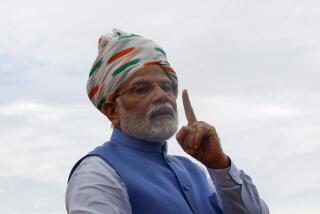India and Pakistan at 50: Progress but Plenty of Pain
- Share via
India and Pakistan marked 50 years of nationhood Friday, a half-century of too much blood and backsliding, poverty and corruption. Yet, amid that gloom, there are accomplishments to celebrate. One is the throwing off of the terrible yoke of colonialism. Another is the right to call themselves democracies, shallow though the roots sometimes seem in the South Asian soil.
Mohandas K. Gandhi led the independence movement and his disciple Jawaharlal Nehru proclaimed India’s “tryst with destiny.” Nehru said, “At the stroke of the midnight hour, when the world sleeps, India will awake to life and freedom.” Westward across a newly drawn border, Muhammad Ali Jinnah was the quaid-e-azam, the great leader of free Pakistan.
But in that terrible year of 1947, Hindus and Sikhs leaving Pakistan for India fought savagely with Muslims heading the other way. More than 500,000 people died in the bloodletting. The two nations later fought wars over Kashmir and East Pakistan, which became Bangladesh.
Today India and Pakistan command the world’s attention not only for their enormous populations--over 1 billion people combined--but for their struggles to retain democracy. Both possess the ability to construct nuclear weapons and perhaps have them already. It’s some comfort that at a half-century of independence the regimes of the countries have resumed bilateral talks to ease tensions. But it is a mark of the fragility of relations that discussions, rather than accomplishments, are the measure of progress.
Allegations of corruption have been laid at the feet of past prime ministers of both nations; in India the chief executive of one of the poorest states, Bihar, has been charged with stealing from the public purse.
For too many years too many politicians, from the prime minister’s rostrum to the village leader’s hut, have promised to end poverty and improve education, but opportunities to do both, by distributing land and building schools, have been shamefully squandered. In recent years violence has increased, with Muslims of various sects killing each other in Pakistan and Hindus battling Muslims and Sikhs in India. Secessionist movements in Punjab and Kashmir plague India.
Yet the two nations have endured. Indian leaders always worried that the nation would shatter, that adherents of its five major religions and speakers of its 18 major languages--and hundreds of dialects--would fracture society like a hammer on crystal. That has not happened, yet. Pakistan, after losing its eastern wing during the 1971 civil war, has pressed on as well, trying to minimize the impact of the war in next-door Afghanistan that followed the Soviet invasion of 1979.
There has been progress, though slower than anyone would like. Life expectancy has increased and literacy rates have gone up. The Indian subcontinent is no longer synonymous with famine.
Both nations have wisely moved toward accepting more foreign investment. It was understandable that India tried to be self-sufficient in reaction to its long dependence on British colonialism, but the socialist system it adopted did not serve it well.
The end of the Cold War dramatically changed the positions of India and Pakistan on the world stage. No longer would the dominant perception be India and the Soviet Union on one side and the United States and Pakistan on the other. But Islamabad and New Delhi must work harder in the new world to forge peace. Money should be spent on health and education, not armies and weapons. The two great nations of South Asia have journeyed far in half a century. They still have a long distance to go.
More to Read
Sign up for Essential California
The most important California stories and recommendations in your inbox every morning.
You may occasionally receive promotional content from the Los Angeles Times.








